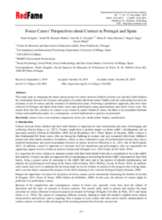Displaying 591 - 600 of 2163
This study aims at comparing the nature and processes of contact between children in foster care and their birth families; the relationship between the existence and quality of contact and foster carers’ burden; and the relationship between the existence or not of contact and the existence of reunification plans.
This exploratory data analysis of 937 children in 522 families in one London local authority sought to identify trends in the length, outcome and nature of pre-proceedings and proceedings cases, including outcomes six, twelve and twenty-four months after the end of these processes.
This chapter from 'Families in Motion: Ebbing and Flowing through Space and Time' explores an overlooked theme across the literature: capturing the experience of childhood family disruption and transitional flux between foster family homes and the independent sensemaking into the present of young care-experienced parents.
Building on 10 qualitative interviews with parents of children in Norwegian Child Welfare Services, this paper discusses parents' views on collaboration between children and child welfare professionals.
The literature examining reunification for American Indian children reveals mixed findings regarding racial differences. Studies that isolate the impact of race on reunification while controlling for other covariates are needed, and this study fills that gap.
In this study, a sample of 97 (out of 505) foster care workers in Flanders (Dutch speaking part of Belgium) from all foster care agencies were asked to answer in writing the question: “What characteristics does a successful foster family have?”
This exploratory study gathered perspectives from legal professionals regarding the challenges faced by youths in out of home care and their families and necessary supports to promote successful reunification.
The present study is the largest and most rigorous study to date on the effects of being appointed a Court Appointed Special Advocate (CASA) on permanency outcomes of children in foster care.
Child protection-involved children experience disproportionately high criminal justice system contact, yet little is known about the circumstances in which such children offend. This study sought to identify the contexts in which this group of children offend and factors associated with children being charged in each context.
This article explores how children living in foster care create senses of belonging across diverse family relationships. It draws on video diaries made by 11 Danish children living in foster care.

